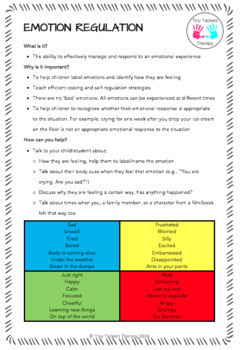Co Regulation For Parents : What it is
As parents, one of our primary goals is to support our children in their emotional development and help them navigate through life's challenges. One essential aspect of this journey is co-regulation. Co-regulation is a dynamic process in which parents and caregivers help children manage their emotions and regulate their responses to different situations. In this article, we will explore the concept of co-regulation, its importance, and practical ways you can foster it with your child.
What is Co-Regulation?
Co-regulation refers to the interaction between an adult and a child, where the adult provides emotional and behavioral support to help the child manage their emotions effectively. It involves creating a nurturing environment that enables the child to feel safe, understood, and supported. This process helps children learn how to regulate their emotions independently in the future.

Why is Co-Regulation Important?
Co-regulation plays a crucial role in a child's emotional development and well-being. By co-regulating with your child, you provide them with a positive model of emotion regulation and help them build essential skills for lifelong emotional health. Here are some key reasons why co-regulation is important:
- Promotes self-regulation: Co-regulation teaches children how to manage their emotions effectively. By providing them with the necessary support and guidance, you help them develop self-regulation skills that they can apply to various situations throughout their lives.
- Enhances emotional intelligence: Through co-regulation, children learn to identify and understand their emotions. This process allows them to develop emotional intelligence, which involves recognizing, expressing, and regulating emotions, as well as empathizing with others.
- Strengthens parent-child bond: Co-regulation is a collaborative process that strengthens the bond between parents and their children. By being present and responsive to your child's emotional needs, you foster a sense of trust and security, enhancing the overall parent-child relationship.
Practical Ways to Foster Co-Regulation
Now that we understand the importance of co-regulation, let's explore some practical ways you can foster it with your child:
1. Create an Emotionally Safe Space

Ensure that your home environment is a safe space for your child to express their emotions without fear of judgment or punishment. Encourage open communication and active listening, so your child feels comfortable discussing their feelings with you.
2. Model Emotional Regulation
Your child learns a great deal from observing your behavior. Model healthy emotional regulation by expressing your own emotions in a calm and constructive manner. Use every opportunity to demonstrate how you manage stress, frustration, or other challenging emotions effectively.
3. Validate and Label Emotions
Show empathy and understanding when your child expresses their emotions. Validate their feelings by acknowledging and accepting them. Help them label their emotions, which allows them to process and understand what they are experiencing. For example, say, "I can see that you're feeling frustrated right now. Would you like to talk about what happened?"
Remember, co-regulation is a journey that takes time and practice. Be patient with yourself and your child as you both learn and grow together.
Frequently Asked Questions (FAQ)
Q: What is the difference between co-regulation and self-regulation?
A: Co-regulation involves the support and involvement of an adult, usually a parent or caregiver, to help a child regulate their emotions. Self-regulation, on the other hand, refers to an individual's ability to manage their own emotions and responses independently.
Q: At what age can children start learning to co-regulate?
A: Children begin to develop co-regulation skills from infancy. However, they may not fully understand or utilize these skills until they are around three to four years old. As a parent, you can start supporting your child's co-regulation journey from a very young age.
Q: How can I handle my child's meltdowns effectively?
A: Meltdowns are common during childhood, and it's crucial to approach them with patience and understanding. When your child is having a meltdown, try to remain calm and offer comfort. Use simple language to validate their emotions and encourage them to express their feelings. Provide a safe and quiet space for them to calm down, and once they have regained control, engage in a discussion to understand what triggered the meltdown and how they can better manage their emotions in the future.
In conclusion, co-regulation is an essential concept in supporting your child's emotional growth and well-being. By creating an emotionally safe space, modeling emotional regulation, and validating your child's emotions, you can foster a strong foundation for their self-regulation skills. Remember, building these skills takes time, so be patient and consistent in your efforts to co-regulate with your child. Together, you can navigate the ups and downs of emotions and help your child thrive in all aspects of their life.
Pin On Parenting
 Image Source : www.pinterest.com
Image Source : www.pinterest.com child parenting calm parent control when kids cool emotional choose board keep
Shanker Self-Reg Infographics What Is Shanker Self-Reg®? Understanding
 Image Source : www.pinterest.com
Image Source : www.pinterest.com behaviour shanker self reg stress stuart reframe regulation vs board control understanding visual aids choose kids steps misbehaviour social
Self Regulation - Parent/Teacher Handout By Tiny Tackers Therapy
 Image Source : www.teacherspayteachers.com
Image Source : www.teacherspayteachers.com regulation handout self parent emotion teacher 1613 followers
Pin By Bethany Hogan On Early Childhood Education | Early Childhood
 Image Source : www.pinterest.ca
Image Source : www.pinterest.ca Emotional Regulation In Children. | Children, Temper Tantrums Toddler
 Image Source : www.pinterest.com
Image Source : www.pinterest.com regulation self emotion parentingforbrain infants temper tantrums development
Infographics: Parenting Myths & Co-Regulation - Positive Parenthood
 Image Source : www.positiveparenthood.org
Image Source : www.positiveparenthood.org regulation
Co-Regulation Handout For Parents/ Teachers By Teacher Turned Child
 Image Source : www.teacherspayteachers.com
Image Source : www.teacherspayteachers.com Children Learn How To Regulate Their Emotions Through “co-regulation
 Image Source : www.pinterest.com
Image Source : www.pinterest.com regulation emotions hundreds soothing
Co-regulation handout for parents/ teachers by teacher turned child. Infographics: parenting myths & co-regulation. Emotional regulation in children.. Regulation self emotion parentingforbrain infants temper tantrums development. Pin by bethany hogan on early childhood education